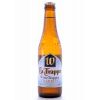Brouwerij de Koningshoeven - La Trappe Witte Trappist
-
ABV:
5.5% -
Serving Temperature:
43-48° F -
Suggested Glassware:
Goblet, Pint Glass, Pilsner Glass
Koningshoeven’s Witte Trappist is the first an only Trappist witbier, and unlike with most other witbiers, there are no spices or citrus peel used in its production. On the pour, there’s a fair amount of haze, as we expect from an unfiltered, bottle-conditioned witbier. The yellowy-golden brew is topped by a pillow of bright white foam that sticks well to the glass. On the nose, a distinctly wheaty malt aroma delivers some bready impressions, while lemon and orange citrus notes bring some overlaying brightness. There are hints of spice too, which speaks to both the hop contribution and, more so, the robust Belgian yeast strain. Flavorwise, wheat forms a lightly crackery, mildly bready core, while the spicy fruitiness expressed in the aroma comes through with vigor. Look for yeasty hints of coriander and white pepper along with a citric and lightly grassy quality delivered by the Saphir aroma hops. We found this beer very nicely balanced between a touch of malty sweetness and those peppery notes, along with a mildly tart impression. This witbier makes a great warm-weather quencher all on its own, but it will excel paired with various seafood like grilled whitefish with lemon, or ceviche. Cheers!
It seems somewhat odd to think of monks as brewers (and beer drinkers), but in Europe, monks and beer have a long history together – none more famously than the Order of Cistercians of the Strict Observance, better known as the Trappists. There are many dozens of Trappist monasteries around the world, most producing various goods to support their abbeys and various charitable causes. Among other things, cheese, preserves, liturgical vestments, and even coffins are produced, but it is the beer that is the most well known – a somewhat ironic fact because only 10 true Trappist breweries exist. (It was 7 until recently – 6 in Belgium plus Koningshoeven in the Netherlands – but the last couple years have seen an Austrian, an American, and another Dutch addition.)
Our featured brewery, Koningshoeven, traces its roots back to the 1881 founding of their abbey, Onze Lieve Vrouw van Koningshoeven, in what is now Tilburg, Netherlands. By 1884, the monastery had built a working brewery to sell beer to the local towns. Not long after, the abbey expanded its operations to the point they were actually running multiple local bars. Lager was brewed, which by the early 20th century was very much in vogue.
As with most European breweries, World War II was a very difficult time due to the lack of barley and hops. But, following the war, the abbey set about getting their brewing operation going yet again – which they did. By 1968 they were producing a lot of beer in various styles, including pilsner, bock, and dunkel, so they partnered with other breweries, including Artois, for outsourced production. Apparently, though, by 1980 the monks were over the partnership deal and they took back 100% control of the brewing. It was at this time that they stepped back from lager production and resurrected traditional abbey ale brewing techniques for their new “La Trappe” brand.
1989 saw a major modernization of the brewery. Due to the advancing age of many of the monks, a new partnership was created in 1999 with Bavaria Brewery, a local brewer about a half hour drive to the east. This time, though, the beer would still be brewed within the abbey and monks would still be involved in the brewing process. These days, Brouwerij de Koningshoeven sources barley from local farmers and is increasingly reliant upon solar energy to power their brewery. They were named the Best Socially Responsible Entrepreneur in Tilburg in 2010. Cheers to that!

Unmatched Variety by style, brewery & country
Choose from Five different Beer Clubs offering unmatched variety by brewery,
country of origin, and beer style to suit your specific tastes.


